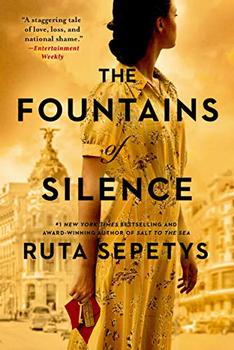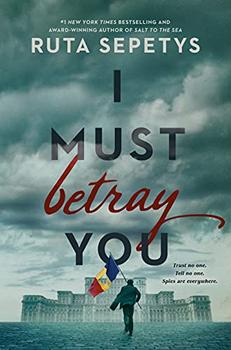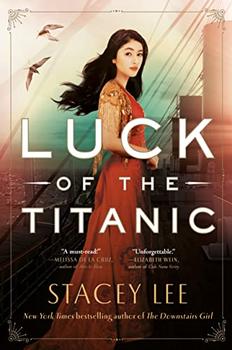Summary | Excerpt | Reading Guide | Reviews | Beyond the book | Read-Alikes | Genres & Themes | Author Bio

The Spanish Civil War and its aftermath was a complicated period in history. The issues each side stood for, the divisions they caused in families, and the silence that shrouded atrocities for decades afterward are not easily explained or understood. In Fountains of Silence, Ruta Sepetys, known for her character-driven historical fiction for young adults, tells the intertwining stories of several teens affected by the turmoil in different ways.
At the center of the novel is a romance between Daniel, an 18-year-old American visiting Madrid with his half-Spanish family in 1957, and Ana, who works in the swank hotel where they are staying. Through Ana, Daniel begins to see behind the carefully crafted facade of peace and normalcy Franco's government projects to tourists, and the continuing conflict between families on both sides of a Civil War that is supposedly long over. Daniel is a talented amateur photographer with a knack for finding subjects often left unseen; the author makes good use of the symbolism of seeing through various lenses. Daniel arrives in Spain when many still remember groundbreaking photojournalist Robert Capa (see Beyond the Book), and his work inspires Daniel's artistic philosophy and portfolio.
One of the photographs he takes is of a nun carrying a dead baby, leading to another story thread, that of Puri, Ana's cousin. Puri works at Madrid's orphanage, where she begins to uncover hints of corruption in both the procurement and the adoption of children—perhaps, even, of Puri herself. At first, Puri seems too much of an innocent, even for the 1950s, but her loss of innocence and the way she processes her childhood experiences into her adult choices are surprising and appropriate, contributing nuance to her characterization.
Yet another thread in this complex story involves Ana's brother and his friend, a homeless teen with passionate dreams of becoming a bullfighter. Bullfighting has not been a common theme in children's or young adult books since the heyday of Ferdinand (1936) or Maia Wojciechowska's Newbery-winning Shadow of a Bull (1964); here, Sepetys focuses not on the violence done to the bull, but on the difficult and dangerous training endured by the men who face death to be idolized by adoring fans.
In less skilled hands, these diverse storylines, each strong enough to be a book in itself, could be confusing. Sepetys, however, has shown in Salt to the Sea, her 2016 novel about the sinking of the MV Wilhelm Gustloff, that she can weave together multiple points of view effectively. Each of her major characters has depth; each is explored with equal honesty; none exist just to expound a contrasting point of view.
The weakest segment of The Fountains of Silence is Part 2, which takes place almost 20 years after Daniel and Ana's initial romance. Daniel returns to the Madrid he remembers from his youth, and of course while there he seeks out the friends he made so many years ago. While young adult readers would naturally be curious about what becomes of the teenage characters, they are now in their 30s, and probably less intrinsically interesting to adolescents. (This tendency towards a many-years-later epilogue seems to be a trend in young adult novels, as Nicola Yoon does something similar at the end of The Sun Is Also a Star.) In her Author's Note, Sepetys acknowledges that she is a crossover author, enjoyed by both teen and adult readers; this final section of her latest book, while tying up a number of loose ends, seems written more for the latter audience.
Ruta Sepetys is unafraid of tackling disturbing but little-known episodes in history, from Lithuanian exiles under Stalin, to the aforementioned Wilhelm Gustloff tragedy. Her exploration into the effects on children and teens of the Spanish Civil War and the decades-long reign of Francisco Franco will be a welcome addition for educators in search of an entertaining and accessible way to explain something so nearly inexplicable.
![]() This review was originally published in The BookBrowse Review in November 2019, and has been updated for the
October 2020 edition.
Click here to go to this issue.
This review was originally published in The BookBrowse Review in November 2019, and has been updated for the
October 2020 edition.
Click here to go to this issue.

If you liked The Fountains of Silence, try these:

by Ruta Sepetys
Published 2023
A gut-wrenching, startling historical thriller about communist Romania and the citizen spy network that devastated a nation, from the #1 New York Times bestselling, award-winning author of Salt to the Sea and Between Shades of Gray.

by Stacey Lee
Published 2022
From the critically-acclaimed author of The Downstairs Girl comes the richly imagined story of Valora and Jamie Luck, twin British Chinese acrobats traveling aboard the Titanic on its ill-fated maiden voyage.
Heaven has no rage like love to hatred turned, Nor hell a fury like a woman scorned.
Click Here to find out who said this, as well as discovering other famous literary quotes!
Your guide toexceptional books
BookBrowse seeks out and recommends the best in contemporary fiction and nonfiction—books that not only engage and entertain but also deepen our understanding of ourselves and the world around us.